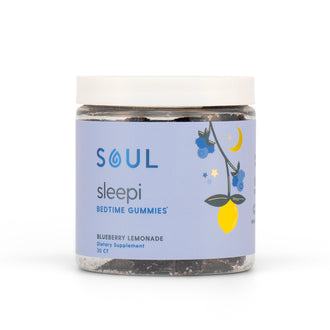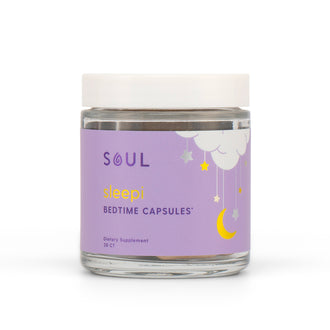
Key Takeaways:
- Understanding Cannabis for Nausea Relief: Cannabis interacts with the endocannabinoid system to target nausea at its source.
- Choosing the Right Approach: Methods like smoking, edibles, and CBD oil each have unique benefits and considerations for nausea relief.
- Safe and Responsible Use: Knowing when and how to use cannabis, including legal and health implications, ensures optimal outcomes.
Nausea can hit at the most inconvenient times, leaving you feeling drained and desperate for relief. Whether it’s a one-off experience or a recurring challenge tied to a medical condition, finding a solution that works can feel like a never-ending search.
At Soul, we know the importance of holistic, high-quality remedies for your well-being. As a trusted leader in premium CBD products, we pride ourselves on offering natural, research-backed solutions designed to help you feel your best. Our carefully crafted CBD oils and gummies are third-party tested and made with transparency and care, giving you the confidence to tackle life’s challenges.
In this article, we’ll examine whether cannabis can be a reliable solution for nausea, breaking down the science, benefits, and considerations to guide your decision.
What Causes Nausea?
Nausea is a queasy, uncomfortable sensation in the stomach that often feels like you might vomit. It’s not a condition itself but a symptom triggered by various underlying factors. Here’s a quick look at some common causes of nausea:
- Motion Sickness: Caused by repeated movements like riding in a car, boat, or plane, which disrupt the inner ear's balance system.
- Medication Side Effects: Certain drugs, including chemotherapy or painkillers, can irritate the stomach or affect brain signals.
- Migraines: Intense headaches can trigger nausea and vomiting as part of their symptoms.
- Digestive Issues: Stomach infections, food poisoning, or conditions like GERD can lead to nausea.
- Hormonal Changes: Pregnancy, particularly during the first trimester, often comes with morning sickness.
- Stress and Anxiety: Emotional distress can upset the stomach and cause nausea.
- Brain-Gut Connection: The vagus nerve, which links the brain and gut, plays a role in transmitting signals when something is off, leading to nausea.
- Underlying Illnesses: Conditions like vertigo, appendicitis, or even heart attack can present nausea as a symptom.
Nausea acts as the body’s way of signaling that something isn’t right, whether it’s a temporary imbalance or a sign of a larger issue.
How Does Weed Work To Alleviate Nausea?
Cannabis, commonly known as weed, has shown promise in alleviating nausea by interacting with the body's endocannabinoid system (ECS). This complex network of receptors helps regulate several critical functions, including mood, appetite, and nausea. By targeting this system, cannabis addresses the root causes of nausea effectively. Below, we’ll explore how this interaction works in greater detail.
The Endocannabinoid System And Nausea Regulation
The endocannabinoid system (ECS) is a network of receptors found throughout the brain and body that plays a key role in maintaining balance or homeostasis. When nausea occurs, it is often the result of disrupted signals within this system. Cannabis compounds, like THC and CBD, bind to these receptors, helping to restore balance and calm the brain's response to nausea triggers.
THC’s Role In Easing Nausea
Tetrahydrocannabinol (THC), the psychoactive compound in cannabis, directly interacts with receptors in the brain that regulate nausea and vomiting. This interaction essentially reduces the body's nausea response by altering the signals being sent to the brain's emetic (vomit-inducing) center. THC’s targeted effects make it particularly useful for severe cases, such as those caused by chemotherapy or other medical treatments.
CBD’s Contribution To Nausea Relief
While THC often gets the spotlight, cannabidiol (CBD) also plays a role in alleviating nausea. CBD’s non-psychoactive nature allows it to interact with ECS receptors in a way that reduces inflammation and soothes the gut. Additionally, CBD can reduce anxiety, which is often linked to nausea, creating a dual benefit for both mind and body.
Cannabis And Emotional Relief
Nausea isn't just physical; it often comes with an emotional toll, including stress or anxiety. Cannabis helps address these aspects by promoting relaxation and reducing anxiety through its calming effects on the nervous system. This dual action—calming both the body and the mind—makes cannabis a comprehensive tool for managing nausea, especially in chronic or severe cases.
Different Cannabis Compounds And Their Effects On Nausea
Cannabis isn’t a one-size-fits-all solution, especially when it comes to nausea relief. Its effects largely depend on the specific compounds within the plant, known as cannabinoids and terpenes. Let’s break it down:
THC: The Powerhouse For Nausea Relief
THC is the primary compound responsible for cannabis’s anti-nausea effects. By binding to CB1 receptors in the brain, it directly suppresses the signals that cause nausea and vomiting. This is why THC-based medications like dronabinol are often prescribed to cancer patients.
CBD: The Soothing Sidekick
While CBD doesn’t bind to receptors in the same way THC does, it offers anti-inflammatory and calming effects that can enhance nausea relief. CBD is especially helpful for people who want the benefits of cannabis without the “high” that THC induces.
Terpenes: Aromatic Boosters
Terpenes, the compounds that give cannabis its unique aroma, may also play a role in fighting nausea. For example, limonene (found in citrusy strains) has mood-boosting and anti-nausea properties, while myrcene (a more earthy terpene) may enhance relaxation.
The Entourage Effect
When THC, CBD, and terpenes work together, they create what’s known as the "entourage effect." This synergy makes full-spectrum cannabis products particularly effective for managing nausea compared to isolated compounds.
When Should You Consider Weed For Nausea Relief?
Using cannabis for nausea relief can be a highly effective option, but it’s not always the first approach. The decision often depends on the cause of your nausea, the severity of your symptoms, and your comfort level with cannabis use. Below are some situations where cannabis may be a suitable option for addressing nausea.
Chronic Illness And Persistent Nausea
For individuals with chronic conditions like cancer, Crohn’s disease, or HIV/AIDS, nausea can be a daily, debilitating symptom. Cannabis has proven to be particularly helpful in managing persistent nausea associated with these illnesses, especially when traditional treatments fail to provide relief. Chemotherapy patients, in particular, often find cannabis to be an effective way to combat the severe nausea and vomiting caused by their treatments.
Managing Medication-Induced Nausea
Certain medications, including painkillers, antibiotics, or chemotherapy drugs, can cause nausea as a side effect. In such cases, cannabis can help alleviate the discomfort by counteracting these effects. However, it’s crucial to consult with a healthcare provider before using cannabis to ensure it won’t negatively interact with your medication or treatment plan.
Anxiety-Related Nausea
Nausea caused by anxiety can be both physically and emotionally draining. Cannabis can address this by reducing the queasy feeling in the stomach while also easing the anxiety that contributes to the sensation. Its dual action on the mind and body makes it a compelling option for those whose nausea stems from stress or mental health challenges.
Temporary Or Occasional Nausea
Even in cases of occasional nausea, such as that caused by motion sickness or mild digestive issues, cannabis can provide quick relief. Low doses, in particular, are effective in calming the stomach without overwhelming the system. However, it’s important to choose strains and methods of consumption carefully, as excessive THC can sometimes aggravate nausea symptoms.
Other Alternative Remedies For Nausea
If cannabis isn’t the right fit for you, don’t worry—there are plenty of other remedies that can help manage nausea effectively. Here are some tried-and-true options:
- Ginger: Ginger has been a go-to remedy for nausea for centuries. Whether in tea, candy, or fresh slices, it works by calming the stomach and reducing inflammation. It’s especially helpful for motion sickness and pregnancy-related nausea.
- Peppermint: Peppermint oil or tea can soothe your stomach and reduce the queasy feeling. Its refreshing scent alone can sometimes alleviate nausea, making it a great, simple remedy.
- Acupressure or Acupuncture: Both techniques target specific pressure points that help reduce nausea. For example, applying pressure to the P6 point (located on the wrist) has been shown to ease motion sickness and post-surgery nausea.
- Stay Hydrated: Sipping on clear fluids like water, herbal teas, or electrolyte solutions can prevent dehydration, which often worsens nausea. Cold drinks in small sips tend to be gentler on the stomach.
- Over-the-Counter Options: Medications like antihistamines (e.g., Dramamine) or antacids can be effective for mild to moderate nausea. Always follow dosage instructions and consult a doctor if needed.
- Lifestyle Adjustments: Sometimes, small changes can make a big difference. Eating smaller meals, avoiding spicy or fatty foods, and getting fresh air can all help ease an upset stomach.
- Relaxation Techniques: For nausea tied to anxiety or stress, mindfulness practices like deep breathing, meditation, or light yoga can be surprisingly effective.
These alternatives can work alone or alongside cannabis, depending on your needs and preferences. If one method doesn’t work, don’t hesitate to try another—it’s all about finding what helps you feel better.
Final Thoughts
When it comes to managing nausea, cannabis offers a unique ability to address both its physical and emotional aspects. This makes it a powerful option, particularly for those with chronic or severe nausea caused by conditions like chemotherapy, Crohn’s disease, or anxiety. For many, cannabis can be life-changing when traditional remedies fall short. However, its suitability depends on factors like the underlying cause of your nausea, your overall health, and your familiarity with cannabis. Starting with a low dose, selecting the right strain, and consulting a healthcare professional are key steps to using cannabis responsibly and effectively.
For those new to cannabis or in regions where it’s not legal, alternative remedies like ginger, peppermint, or lifestyle changes may be worth exploring. These natural options can provide relief for more common or mild causes of nausea. Ultimately, the best approach is one that aligns with your specific needs and comfort level, ensuring you find relief that restores both your well-being and quality of life.
Read also:
- CBD Gummies for Nausea: Get Relief Now
- CBD Oil for Nausea: Effective Relief
- Migraine Relief with CBD Oil
Frequently Asked Questions How Weed Can Help With Nausea
Can weed help with nausea caused by food poisoning?
Cannabis may help alleviate nausea caused by food poisoning by interacting with the endocannabinoid system, but staying hydrated and addressing the root cause is crucial.
What strains of weed are best for nausea relief?
Strains high in THC, such as OG Kush or Sour Diesel, are commonly reported to help with nausea. CBD-dominant strains can also be effective for calming the stomach.
Does consuming weed on an empty stomach help nausea faster?
It’s not recommended. Consuming cannabis on an empty stomach might intensify its effects, which could worsen nausea for some individuals.
How does smoking weed compare to edibles for nausea relief?
Smoking or vaping provides quicker relief as it enters the bloodstream faster, while edibles take longer to kick in but may offer prolonged effects.
Can CBD oil alone reduce nausea without THC?
Yes, CBD oil has shown promise in reducing nausea, particularly when inflammation or stress is the trigger. It’s also a non-psychoactive option.
Is it safe to use weed for nausea during pregnancy?
Using weed during pregnancy is controversial and not recommended by most health professionals due to potential risks to fetal development.
How long do the anti-nausea effects of weed typically last?
The effects can last anywhere from 2 to 6 hours depending on the method of consumption and individual tolerance.
Can microdosing cannabis help with nausea without getting high?
Yes, microdosing small amounts of THC can provide relief from nausea while minimizing psychoactive effects.
Is it legal to use cannabis for nausea in all states?
Cannabis laws vary by state. In some places, it’s permitted for medical use with a prescription, while in others, it’s fully legal or still prohibited.
Are there specific products at Soul that can help with nausea?
Soul’s CBD tinctures and gummies, crafted with natural ingredients and third-party tested, may help alleviate mild nausea with calming, non-intoxicating effects.
Sources:
- The Medicinal Power of Cannabis. (2015). Google Books. https://books.google.com/books?hl=en&lr=&id=qTCCDwAAQBAJ&oi=fnd&pg=PP6&dq=how+does+weed+
relieve+nausea&ots=op4qvDsum5&sig=gxX2sJk051cPNUHZc5bn2iJfvLA - Tramer, M. R. (2001). Cannabinoids for control of chemotherapy induced nausea and vomiting: quantitative systematic. BMJ, 323(7303), 16–16. https://doi.org/10.1136/bmj.323.7303.16
- Sharkey, K. A., Darmani, N. A., & Parker, L. A. (2014). Regulation of nausea and vomiting by cannabinoids and the endocannabinoid system. European Journal of Pharmacology, 722, 134–146. https://doi.org/10.1016/j.ejphar.2013.09.068






